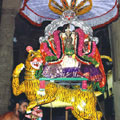|
|
 |
 |
| Temple Images |
|
|
The structure of a temple guides a devotee's experience of the sacred images housed within it. The image contained in the "womb-chamber" (garbha-griha) at the center of the temple is the focal image, religiously as well as architecturally. The central shrine image can be either anthropomorphic or non-anthropomorphic (aniconic). Anthropomorphic images are common in temples dedicated to Vishnu (Figure 1); the stance of this figure suggests it was a central shrine image. Non-anthropomorphic images may be natural or human-made, such as the cylindrical shiva linga (Figure 2) found in temples dedicated to Shiva. While the shiva linga always occupies the central shrine of Shiva temples, anthropomorphic images are almost always used as exterior decoration and in procession. Whether or not the images have human form, they are honored and adorned with flowers and jewels, as befits royalty.
Temple images can be either movable or installed permanently within the temple. The central temple image (mula murti) is usually immovable. Once it is installed, it is never taken out of the temple again except in times of danger. Movable or processional images are called "festival images" because they are used primarily for festival processions, when the deity is carried on parade outside the temple walls, to interact directly with devotees. These dedicated processional images only represent the central deity of the temple at these times. The rest of the time, they are either stored out of sight or in the shrine, near the central image. Many of these processional images are therefore permanent, and are made of metal or stone (Figure 3). Others are made of ephemeral material, such as unfired clay, and are discarded at the conclusion of a festival. Deities can be carried in procession in large carts, on animal mounts, in small portable shrines, or on other vehicles (Figure 4). Murugan, pictured here, is the son of Shiva and Parvati; he is known by many other names, including Skanda (common in the north of India) and Subrahmanya (known primarily in the south).
Modern temples differ from traditional temples in the way images are displayed, in several important respects. They often have a large variety of deities within the central shrine area, even when the temple is ostensibly devoted to a single deity (Figure 5). A temple dedicated to the Goddess, for example, may feature a shiva linga in a prominent shrine. Modern temples often do not include the traditional garbha-griha; instead, a large number of icons is displayed in a hall-like setting, to allow the devotee sight (darshan) of the full array of deities. Many temples, as well as home shrines, make use of modern lithographic images of Gods in addition to three-dimensional images (Figure 6). Posters can portray deities, heroes, sacred sites, or even temple icons themselves.
< previous next >
Top |
|
 |
 |
| Click for details |
 |
 |
 |
Fig. 1
|
 |
 |
 |
Fig. 2
|
 |
 |
 |
Fig. 3
|
 |
 |
 |
Fig. 4
|
 |
 |
 |
Fig. 5
|
 |
 |
 |
Fig. 6
|
 |
|
 |


